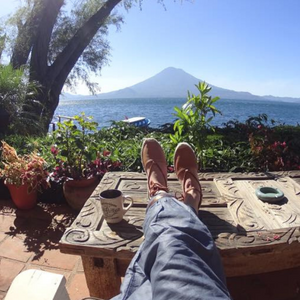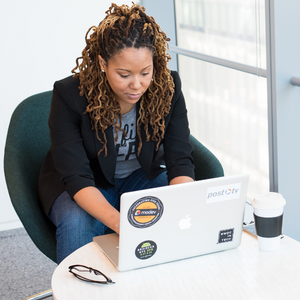Three Ways to Move Into The Self-Care of Thriving
 As we hit the midpoint of the year and get into summer, let’s take a break from going through the motions to re-evaluate and practice self-care: what do you need to do for yourself to restore and regenerate?
As we hit the midpoint of the year and get into summer, let’s take a break from going through the motions to re-evaluate and practice self-care: what do you need to do for yourself to restore and regenerate?
Too much of self-care talk focuses on topping up the energy you have depleted so you can survive the daily grind. Self-care is not really about getting by, but committing to yourself and your authenticity so you can thrive.
Prioritizing self-care is about restoring your energy and your connection within, so that life becomes more energy-generative.
Here are three ways to practice self-care so you can feel more alive in your skin:
1. Get Back Into Relationship With Your Body
How often have you overrode your body’s messages – be it forgoing rest, healthy food or physical activity – while striving to do everything else that seemed ‘more important’? Women are especially prone to burnout at work and the long hours game has a disproportionally damaging effect on women’s health.
Overvaluing the mental urge towards productivity while disconnecting from our physical bodies moves us away from health and the feminine wisdom of our bodies. When you lose intimacy with your body, you lose the ability to access gut feelings, intuition and valuable emotional guidance.
As Stephen Covey would put it in The 7 Habits of Highly Effective People, you also make the mistake of prioritizing production at the expense of nurturing your production capability, which is only good for short-terms external wins but ultimately exhausts your ability to show up, especially for yourself.
This summer, really get into your body. Not just as a means to another end, such as running off the stress or shedding pounds. And don’t just recharge your body: you were not born to be a battery. Moving your body is not the same as being in a listening relationship with your body. Instead, re-attune to your body. Restore the connection with self, starting here.
Consider a yin yoga class, a restorative yoga class or perhaps 5 rhythms dance. Or let the sun pour in through your skin for twenty minutes. Do something new or slow or fast that brings your awareness back to the simplicity of your ‘being’ and the innate guidance of your body.
Your ‘doing’ will only benefit from bringing it into balance with your ‘being.’
2. Experience “Immersive” Time
“We wake up in the morning and we say, ‘I didn’t get enough sleep.’ And we hit the pillow saying, ‘I didn’t get enough done,’” says Brené Brown.
We conduct our busy work lives in linear time, which helps gives rise to the cultural narrative of scarcity, and the persistent feeling that you can never do enough. But the one-way march of time is just one left-brained frame for experience where we often end up “hustling for our worth,” as Brown puts it.
The seasons of nature and the physiology of the female reproductive body reveal the right-brained frame of cyclical time. What psychologist Mihaly Csikszentmihalyi describes as a state of Flow and the Greeks called kairos is yet another experience of time that is alive, creative, connected and synergistic.
“Chronos is clocks, deadlines, watches, calendars, agendas, planners, schedules, beepers…Kairos is transcendence, infinity, reverence, joy, passion, love, the Sacred… We exist in chronos. We long for kairos. That’s our duality,” writes Sarah Ban Breathnach, in her NYT bestseller Simple Abundance: A Daybook of Comfort and Joy. “Chronos requires speed so that it won’t be wasted. Kairos requires space so that it might be savored. We do in chronos. In kairos we’re allowed to be. It takes only a moment to cross over from chronos into kairos, but it does take a moment. All that kairos asks is our willingness to stop running long enough to hear the music of the spheres.”
This summer, drop into immersive time more often. A key quality is that the experience of presence and participation themselves are the reward of this time, not the result.
Perhaps it’s getting lost in adventures with your family or a deep conversation. Perhaps it’s a long walk or drive in nature. Reading a book. Cooking a homemade meal. Dancing or painting or writing or meditation or playing an instrument. Whatever activity makes you forget both yourself and the world because you are so inside of it, that’s the gold.
In a feminine sense of creativity, we do not forgo self-care in order to labor ‘at all costs’ for what is, relative to our health, an abstract outcome. We value and care for ourselves throughout the process as the experience is the creation. Tapping into immersive time increase your well-being, your creativity and your productivity, too.
3. Rediscover How To Use Your “No”
Halfway through the year is a good time to step back and ask where your time and energy is going and whether it’s adding up to create fulfilling meaning for you, rather than just ticking off your list or other’s needs.
As in Covey’s famous time management matrix, are you steadily putting energy and resource into the Quadrant 2 area of “not urgent but important” in your life? This is often the hardest area to devote yourself to when life pulls from all directions, so take a break to get an overview of your energy investment relative to your real values and desires.
More than ever, our energy is susceptible to be whittled away by low importance matters of false urgency, as 24/7 responsiveness and social media addiction has become normalized. Look at the hours you’ve spent on the phone in a day and ask if you deposited anything in the investment bank of your heart? How much was truly connection and how much was distraction?
When our commitments, as demonstrated by habit, are not aligned with our values-based desires, we begin to feel the pain of disconnection with self.
Realignment of energy with values is going to require emotional attuning.
One question that can be useful is to ask: What is the one thing I am getting angry/resentful for not doing? If you’re giving all your energy away except to the thing that’s really important to you, you will begin to feel like the world is crashing in on your personal boundaries. Now, how can you choose time to prioritize what you yearn for? Can you let discipline come from love?
As part of trauma exploration, Gabor Maté, M.D. talks about how most of us ‘wisely’ adapted to give up our authenticity for attachment as children. But when we continue to forgo our authentic needs, due to the stories and guilt we’ve cultivated, it causes stress, suffering and disease. He asserts that if you can’t say ‘no’, your body will.
According to Maté, women have a harder time saying no and suffer the health consequences. One essential step in self-care, and restoring your authenticity, is relearning how to give an authentic ‘no’ – whether in work or personal life.
Maté suggests to ask the following questions around saying ‘no’:
- Where in my life do I have difficulty saying no?
- What story did I tell myself about why I couldn’t say no?
- Is that story really true?
- What is the impact on myself when I don’t say no?
Thrive, Not Survive
This summer, think about self-care not as a way to survive the grind of your life, but to step a little further into thrive, whatever that authentically means for you!
By: Aimee Hansen
Note: We are taking a publishing break and our own advice and we will see you on Monday 12th July, and remember we have over 5000 articles to read in the archives if you are missing our cutting edge career insights!










